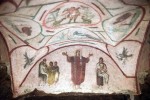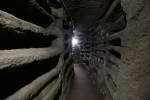 The Catacombs of Priscilla in Rome, an eight-mile network of warrens on several levels dug out of soft volcanic tufa used for Christian burials from the second century A.D. through the fifth, have been re-opened after five years of conservation. Restorers used laser technology to clean the wall paintings, a highly significant collection of early Christian iconography that includes the earliest known depiction of the Madonna and Child dating to around 230 A.D. and, in a room known as the Cubiculum of the Veiled Woman, a later third century depiction a woman with arms outstretched wearing what the Vatican’s Italian language website calls “a rich liturgical vestment” (the English version calls it “a rich purple garment”) which some consider evidence of female clergy in early Christianity. In the newly-dubbed Cubiculum of Lazarus, lasers revealed a fourth-century fresco of Christ raising Lazurus, still wrapped in his shroud, from the dead. This work had been obscured by centuries of grime.
The Catacombs of Priscilla in Rome, an eight-mile network of warrens on several levels dug out of soft volcanic tufa used for Christian burials from the second century A.D. through the fifth, have been re-opened after five years of conservation. Restorers used laser technology to clean the wall paintings, a highly significant collection of early Christian iconography that includes the earliest known depiction of the Madonna and Child dating to around 230 A.D. and, in a room known as the Cubiculum of the Veiled Woman, a later third century depiction a woman with arms outstretched wearing what the Vatican’s Italian language website calls “a rich liturgical vestment” (the English version calls it “a rich purple garment”) which some consider evidence of female clergy in early Christianity. In the newly-dubbed Cubiculum of Lazarus, lasers revealed a fourth-century fresco of Christ raising Lazurus, still wrapped in his shroud, from the dead. This work had been obscured by centuries of grime.
 The Priscilla catacombs are thought to have been named after the wife of Manius Acilius Glabrio, Roman Consul in 91 A.D. (the future emperor Trajan was his co-consul) executed by Domitian for atheism, ie, his refusal to worship the Roman gods because he was Christian. She had him buried in what was once a quarry and donated the property to the church so others could be buried there. It’s known as the “Queen of the Catacombs” because of the art work and because so many martyrs and popes were buried there. Popes Saint Marcellinus (296-304), Saint Marcellus I (308-309), Saint Sylvester I (314-335), Liberius (352-366), Saint Siricius (384-399), Saint Celestine I (422-432) and Vigilius (537-555) were laid to rest in the Catacombs of Priscilla, as were the following martyrs: brothers Felix and Philip, probably killed under Diocletian, their mother Felicity and five of their other brothers (Alexander, Martial, Vitale, Silanus and Januarius), Saint Philomena, Saint Pudens and his daughter Saint Praxedes. His other daughter Saint Pudentiana is buried next to her father, but there are no surviving accounts of whether she was martyred.
The Priscilla catacombs are thought to have been named after the wife of Manius Acilius Glabrio, Roman Consul in 91 A.D. (the future emperor Trajan was his co-consul) executed by Domitian for atheism, ie, his refusal to worship the Roman gods because he was Christian. She had him buried in what was once a quarry and donated the property to the church so others could be buried there. It’s known as the “Queen of the Catacombs” because of the art work and because so many martyrs and popes were buried there. Popes Saint Marcellinus (296-304), Saint Marcellus I (308-309), Saint Sylvester I (314-335), Liberius (352-366), Saint Siricius (384-399), Saint Celestine I (422-432) and Vigilius (537-555) were laid to rest in the Catacombs of Priscilla, as were the following martyrs: brothers Felix and Philip, probably killed under Diocletian, their mother Felicity and five of their other brothers (Alexander, Martial, Vitale, Silanus and Januarius), Saint Philomena, Saint Pudens and his daughter Saint Praxedes. His other daughter Saint Pudentiana is buried next to her father, but there are no surviving accounts of whether she was martyred.
Such a rich connection to important figures of the early Church made the Priscilla catacomb a target of looters. That’s why it was forgotten for almost a thousand years, because, like many other catacombs at the time, its entrances were deliberately blocked and hidden in the sixth century to protect it during a period when Rome was being sacked on a regular basis. It was one of the first catacombs to be rediscovered in the 16th century, and then the local sackers got to work stealing tombstones, sarcophagi, tufa blocks and the remains of presumed martyrs.
 Thankfully they left the paint of the walls, and eight labyrinthine miles are hard to completely strip of all their contents so when archaeologists began excavating the site in the late 19th century, they found around 750 marble fragments of funerary art. These pieces of sarcophagi and funerary inscriptions have been kept for a century plus in a space in the basilica of San Silvestro, a new church built over the foundations of a fourth century one in 1907. In addition to the conservation of the catacombs themselves, the project saw the construction of an innovative new museum to house these pieces. They needed restoration and they needed to be displayed in a suitable context, so a museum was built over what was still an open archaeological site.
Thankfully they left the paint of the walls, and eight labyrinthine miles are hard to completely strip of all their contents so when archaeologists began excavating the site in the late 19th century, they found around 750 marble fragments of funerary art. These pieces of sarcophagi and funerary inscriptions have been kept for a century plus in a space in the basilica of San Silvestro, a new church built over the foundations of a fourth century one in 1907. In addition to the conservation of the catacombs themselves, the project saw the construction of an innovative new museum to house these pieces. They needed restoration and they needed to be displayed in a suitable context, so a museum was built over what was still an open archaeological site.
They covered the foundations of the ancient church, which still contains many burials, with a pavement made out of panels of clear glass, metal gratings or imperial travertine. The clear panels cover the areas with significant archaeological remains so visitors to the museum can look down and see the ruins. The gratings provide air flow to the remains to ensure moisture levels don’t rise encouraging the growth of destructive vegetation and microorganisms. They also provide easy access for future maintenance of the archaeological material because they can be easily removed. The travertine was chosen because of its durability and because it is aesthetically in keeping with its surroundings. Its opacity obscures cables and other unsightly fundamentals of modern construction.
The Museum of Priscilla has its own website now and it’s actually good, something worth noting since so many archaeological sites have truly atrocious websites if they have any web presence at all. It’s only in Italian but it’s worth browsing even if you have to use an online translator. The videos do not have English captions but I still think you should watch them if only to see how the museum came together. It’s quite spectacular.
This video covers the process of museum construction from early rejected concepts to final execution. Watch it to see the space go from display room with a solid floor covering ruins protected solely by burial in sand into a floorless archaeological site into a handsome, multi-layer, non-invasive one-room museum.
[youtube=http://youtu.be/42hHJdHSPO0&w=430]
This one describes the construction of the floor, the three different kinds of panels, their uses, why the materials were chosen:
[youtube=http://youtu.be/k6hJpkynU-A&w=430]
Doesn’t that combination floor look great? I think it’s brilliant.
The following video shows the restoration of the 750 fragments. My quick translation of the main points: three restorers worked on the fragments for two and a half years. In the early 1900s, the marbles were affixed to the church wall with iron hooks and mortar. They needed to be cleaned of oxidized iron, cementacious materials and concretions accumulated over the centuries underground. The cement was so much harder than the ancient marble that removing it with power microdrills without damaging the marble was a great challenge. They had to use the smallest of bits to do the work. Once cleaned, the fragments were reunited using a special glue. The biggest surprise was the discovery of traces of the original polychrome paint. The figures of people were outlined in red. The fruit is fuxia (I’d call it a raspberry or a purple more than a bright pink, but I’m not there and the restorer is so what she says goes.) There’s so little left because “restorers” in the past scrubbed the marble raw with wire brushes (like the British Museum did to the Elgin marbles in the 19th century). In fact, the one feature all these fragments have in common is that their surfaces are thoroughly scratched.
[youtube=http://youtu.be/W1LtEV8XOKk&w=430]
Finally, if you’d like to get a more detailed view of the Catacombs of Priscilla but can’t make your way to Rome right at this minute, you can tour them on Google Maps! The whole eight miles haven’t been scanned, but you can follow basically the same route you’d take if you were there in person and then some. According to the Giorgia Abeltino of Google Italy, the had to build specialized cameras and instruments to take the Street View process underground, and it pays off. I’ve been in my fair share of catacombs and they are dark, y’all. The virtual tour is illuminated and detailed beyond my wildest expectations.